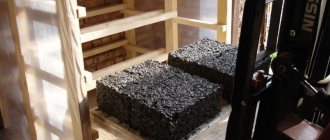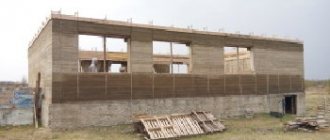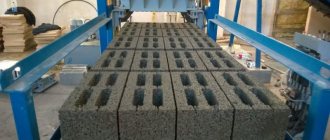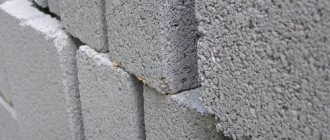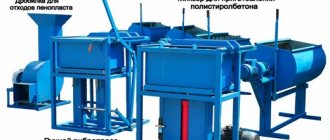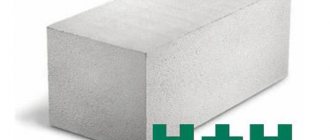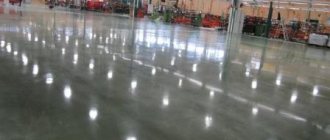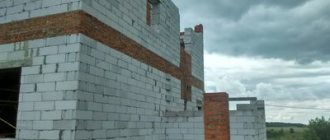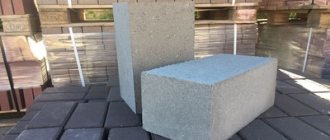One of the main building materials, concrete, is classified according to its strength. Depending on the type of filler, it is divided into light, heavy and super-heavy. Sawdust concrete belongs to the category of lightweight materials because sawdust is used as a filler. Its production was established in the 60s of the last century in the Soviet Union. He received his GOST number 19222-84 called “Arbolite and products made from it” later.
It should be noted that wood concrete is not sawdust concrete, and vice versa. Because in the first one, wood chips of certain sizes are used as filler. In the second, sawdust is used as wood processing waste.
What is sawdust concrete?
The composition of concrete includes: sawdust, cement, sand, lime or clay. Depending on the formulation of the solution, the material is divided into grades, each of which has its own purpose in terms of use in certain building structures.
| Brand | Component proportions | Density, kg/m? | |||
| Cement, kg | Sawdust, kg | Sand, kg | Clay or lime, kg | ||
| M5 | 25 | 100 | 25 | 100 | 500 |
| M10 | 50 | 100 | 100 | 75 | 650 |
| M15 | 75 | 100 | 175 | 50 | 800 |
| M20 | 100 | 100 | 250 | 25 | 950 |
The first two grades of sawdust concrete are used to make blocks that are used for the construction, thermal insulation or repair of the walls of a structure. The last two are used in the construction of the walls themselves (internal and external).
Pay attention to the density of the material, which affects the weight of the products. Maximum density of sawdust concrete – 950 kg/m? (the weight of 1 cube is 950 kg), for brick this figure is 1200, for wood 700, for expanded clay concrete - 1000, for foam concrete - 700. That is, concrete on sawdust is in the golden mean, so blocks made of shavings and cement have a fairly large bearing capacity. But it is necessary to understand that they are used only in low-rise construction, because the raw material is lightweight concrete.
At the same time, blocks made of sawdust concrete, due to the fact that their filler is wooden sawdust and shavings, have low thermal conductivity - 0.08-0.17 W/m K. For example, the thermal conductivity of brick is 0.35, and that of wood is 0. 23, for expanded clay concrete 0.33, for foam concrete 0.16. Therefore, blocks of cement and sawdust are often used as insulation.
Wall masonry
Foam concrete masonry begins with corner blocks, then, focusing on them, the first row of the wall is laid. By the way, for better adhesion to the foundation, masonry mortar is used. Now you need to make reinforcement; for this, two grooves are cut out in the blocks with a grinder for laying reinforcement d=6 mm, then subsequent rows are laid to the required height.
To save on windows, you can make grooves in the walls and insert glass into them at the stage of laying the walls. As they say - cheap and cheerful. The last row is reinforced with an armored belt. An armored belt made of foam concrete formwork would be a good alternative. To do this, material 10 cm thick is taken, laid along the edges, a welded metal frame is laid in the resulting space, and everything is filled with concrete. Once cured, wood beams and tiles can be laid.
Advantages and disadvantages
Considering the pros and cons of sawdust concrete, it is necessary first of all to indicate that the blocks made from it are a wall building material with excellent technical and operational characteristics. The advantages can be added:
- The material is environmentally friendly because it does not contain synthetic components.
- Low water absorption rate of 8-12%. This is when, when exposed to water, the material absorbs a certain amount of it, depending on the weight of the product itself. If a wall built from sawdust concrete blocks is covered with protective compounds, then this technical parameter will be reduced to 3%.
- Blocks made from wood chips and cement (arbolite) and from sawdust and cement belong to the category of non-combustible materials (NG). The stone begins to collapse only at a temperature of +1200C. But this material has one nuance regarding high temperatures. If a large amount of sand is added to the composition of sawdust concrete, then the temperature regime of destruction drops to +573C. Simply, under the influence of high temperatures, sand changes its polymorphic modification. It increases in volume, which contributes to the appearance of deep cracks in the stone.
- The bearing capacity of the blocks is up to 100 kg/cm?, which is a normal indicator for wall materials. In this case, the strength depends mainly on the brand of cement used. Therefore, if the walls are built from sawdust concrete, then it is better to add M500 grade cement to its composition.
- Building blocks made from sawdust and cement are easy to process. They can be cut, drilled, nailed. There is no need to chop or chop them; an ordinary hacksaw can easily handle the stone, precisely adjusting it to the required dimensions.
- Walls made of sawdust concrete can easily be finished or faced with any building materials due to the high adhesion of the surfaces of the blocks.
As for the disadvantages, first of all it must be noted that sawdust, as a reinforcing frame, is inferior to wood chips. Therefore, sawdust concrete products cannot boast of high bending strength. This means that we can talk about the inability of this material to undergo temporary deformation without destruction. Although in the category of lightweight concrete products they are superior to many materials and products.
Sawdust is a loose material; it fills a large space, forming pores. To reduce the porosity of the structure, a lot of sand is added to concrete, which leads to heavier blocks. Because of this, the thermal conductivity of sawdust concrete also increases. In this case, the solution can be made without lime or clay, but there is no way to do without sand. The former are usually added if there is a need to save on the use of cement.
Reviews of sawdust concrete
Numerous reviews of blocks made of sawdust and cement confirm the advantages of the building material, the main one of which is its low thermal conductivity. Houses made of sawdust concrete retain coolness well in hot weather, and keep warm in winter, which allows you to minimize heating costs in the cold season. The high thermal insulation properties of the structural material make it possible to do without additional wall insulation.
Advantages
The advantages of sawdust concrete blocks include:
- Strength. The blocks can be used to construct load-bearing walls of buildings up to three floors high.
- Environmentally friendly and safe - the material does not emit substances or microparticles harmful to health.
- Non-flammability. The blocks can withstand two hours of exposure to flame and temperatures up to 1200°C without ignition.
- Vapor permeability. Due to the porous structure, air exchange through the walls is ensured and excess moisture is removed. This provides a favorable microclimate in the house.
- Good noise insulation properties. Walls and partitions absorb sound waves, which contributes to acoustic comfort.
- Frost resistance. Repeated freezing and thawing of sawdust concrete structures does not lead to their destruction.
- Ease of processing. Sawdust concrete is easy to saw and drill, and is resistant to cracking and chipping.
- Ease of installation. The blocks are quite voluminous, and at the same time have a small mass.
- Durability. Provided effective protection from moisture, block structures last for decades.
- Affordable price. The use of production waste (sawdust) significantly reduces the cost of the material.
- Possibility of self-production. Using available organic raw materials, you can make blocks from sawdust and cement with your own hands.
Flaws
An important disadvantage of sawdust concrete is its fairly high moisture absorption. For this reason it is required:
- Before laying the external walls, arrange a base made of brick or concrete with a height of at least 0.5 meters from the level of the blind area;
- provide for the eaves to extend beyond the plane of the wall to a distance of at least 0.5 meters and equip the roof with a drainage system.
External façade finishing is also used as protection against moisture. It is also necessary to add aesthetics to the building, since the geometry of the blocks is unimportant and thick seams have to be made when laying the walls.
The list of disadvantages also includes the length of time it takes to produce blocks from sawdust and cement. At least 3 months must pass from the moment the molds are poured to the use of finished blocks in construction - during this time the material dries and gains strength.
DIY manufacturing technology
Making blocks from sawdust and cement with your own hands is not a problem. To do this, you will need all the starting materials described above and simple equipment. Namely: a block mold made of boards or sheet metal. If the forms will be used one-time, for example, to make blocks for constructing a shed from sawdust concrete with your own hands, then it is better to use lumber 20 mm thick.
The boards are assembled into one large structure, where they form cells according to the size of the blocks. The number of cells is limited only by the ease of use of the equipment. The form itself must be collapsible, so its elements are fastened together with L-shaped studs bolted to a nut.
It should be noted that the dimensions of the blocks are not established by GOST. Therefore, the work contractor selects these indicators depending on the thickness of the house wall, the width of the openings, installation methods, and other things. Blocks are often produced in sizes: 120x250x140 and 132x275x154 mm.
Attention! During the drying process, the sawdust-based concrete solution undergoes drying out, so the internal dimensions of the form should be 10% larger than the parameters of the blocks being poured.
Preparing sawdust
To make sawdust concrete, it is better to use softwood sawdust, of which spruce sawdust is better than others. Causes:
- The content of water-soluble substances in spruce is 1.12%, in pine 2.6-6.2, in birch 1.3-1.45, in oak 2.5-7.3. The lower the percentage, the faster the solution combines with the wood. There is no rejection of two different materials.
- Concrete drying speed. If spruce sawdust was used, then it takes up to 12 hours for the blocks to dry. If hardwood waste was used, the drying time may take up to 90 hours.
To reduce the amount of water-soluble substances in wood, various methods and technologies are used. Eg:
- spread the sawdust in the sun, thereby reducing its humidity due to evaporation;
- soak the raw material so that water-soluble substances come out of it with water;
- treat sawdust with calcium chloride or liquid glass.
The first two methods are a long process that can take 2-3 months. The latter has certain nuances: liquid glass makes wood brittle; calcium chloride can only be used if the wood has been thoroughly dried beforehand.
Screenings must also be added to the preparation of sawdust. It is optimal if the material is homogeneous. Blocks made from small sawdust will have high thermal conductivity, while blocks from larger ones will have low strength. Therefore, the ideal size of sawdust is within 1-2 cm. Experts recommend taking sawdust from a sawmill (belt or disk), from calibrating and rounding machines, shavings for sawdust concrete are not suitable, they are too large.
Concrete production
What is sawdust concrete? It is ordinary concrete, into which sawdust is added as a filler. Therefore, it must be made in exactly the same way as in the case of ordinary concrete mortar. The main thing is to strictly follow the recipe and sequence of ingredients added. It is better to use a concrete mixer for preparation.
- Cement and sawdust are poured into the concrete mixer drum.
- Then add sand in small portions so that it mixes well with the main components.
- Next, strictly according to the recipe, clay or lime dough, which must be prepared in advance.
- After thorough mixing, water is added in small portions.
Attention! The finished concrete solution is determined by the method of compressing a small part of it in a fist. A plate mass should form, on the surface of which, after compression, fingerprints will remain. At the same time, no drops of water.
Molding
The finished solution is placed in molds where it will be stored for several days until maximum drying. The main task of the work producer is not to procrastinate. The concrete solution “lives” for 1.5-2.5 hours, after which it begins to harden.
The cells are filled with the solution and compacted. After 2-5 days (depending on the drying temperature), the molds are opened. In this state they have 30% strength. Further drying is carried out outdoors, which can take more than one month.
If the form was made of boards, then the internal planes of the cells are covered with plastic film, which prevents moisture from passing from the concrete into the wood. In this case, the film separates the solution from the mold, which will help when disassembling the structure without affecting the integrity of the blocks. If the mold is made of sheet iron, then the inner walls must be coated with processing.
If you want to make blocks with holes, thereby lightening the wall material, then you need to prepare wooden or metal pins. They are installed either before pouring the solution into the cells, or after, sticking them into the solution at the same distance from each other.
Final drying
Sawdust concrete blocks should be dried in the air, preferably not in a draft, by placing them under a canopy and covering them with plastic film. It is important to leave gaps between them for ventilation. Usually the blocks are assembled into pillars of two stones. The bottom two are laid on bricks, the top two across the bottom ones, and in this sequence to a height of up to 10 stones.
After three months, the sawdust concrete mortar in the blocks will gain 90% of its brand strength. Stones can already be used in construction. Finished products must be durable and free from defects in the form of cracks. To check how strong a block is, it must be dropped to the ground from a height of 1 m. If it does not break, then the strength is sufficient.
Preparatory work
In order for chickens to lay eggs well, you need to provide them with comfortable conditions, this is not only warm and dry, but also a fairly spacious room. So, per bird there should be at least a third of one square meter; this area should not include the square footage of the passages.
If you plan to build a multi-story winter chicken coop, then it is important to remember that the ceiling height should not be less than 70 cm. This option for keeping chickens is cheaper to build than a one-story barn. Especially if you have a lot of poultry in your yard.
It is also important for them to properly organize the perch; it can be in the form of perches or a shelf. It must be placed no higher than 1 meter above the main level, otherwise they will not be able to climb there. If the design of the chicken coop involves perches above this level, then you can place a ladder on them, along which the birds can easily climb to their sleeping place. To make everyone comfortable, you need to calculate approximately 30 cm of perch per bird.
If the chicken coop also contains turkeys or guinea fowl, then the conditions for keeping the chickens are also good for them. The area of the premises for one turkey should be at least one meter, and the ceiling height should not be less than one and a half. As for perches, turkeys do not like to sleep on them, so you can build a strong platform for them. The arrangement of a barn for guinea fowl is the same as for chickens.
Technology for constructing sawdust concrete walls
Construction from sawdust concrete makes it possible to save a lot of money. After all, there is no need to build a large and complex foundation for a structure made of this material. Usually a shallow belt is chosen.
As for masonry mortar, there are several options:
- mortar based on sand and cement;
- ready-made heat-insulating mortar with perlite;
- adhesive composition for laying cellular concrete blocks.
The second option is preferable because the seam is filled with a solution that will not act as a cold bridge. And for a house made of concrete blocks, this is an important factor.
The masonry process itself is carried out using identical technology, associated with other block materials. Namely:
- assembly begins from the corners of the building;
- the first row of blocks is laid on sand-cement mortar, as the most durable;
- vertically stacked stones are checked with a plumb line or building level;
- in the horizontal plane, verification is carried out using a thread stretched horizontally;
- the masonry is carried out with a band (offset to the floor or a quarter of the stone), the main thing is that the vertical seams should not coincide;
- To strengthen the wall structure, a synthetic reinforcing mesh is laid between the blocks.
If the masonry row is not to be filled with a whole block, the latter is cut to the required size. In this case, the thickness of the masonry mortar (seam) is taken into account.
Wall decoration
Material made from sawdust and cement does not shrink because it is well dried before installation. Therefore, finishing can be carried out immediately after the construction of the walls and the construction of the roof.
There are no restrictions in this regard. This can be plastering followed by painting, installation of siding, block house or lining, lining with brick, stone, etc. As for interior decoration, plaster with perlite is most often used to increase the thermal insulation properties of the wall.
Material selection
Having made all the necessary calculations and planning for the future building, you can safely go shopping for all the necessary building materials. For the construction of walls, a good foam concrete block with a density grade of at least D400 is suitable; its dimensions are standard. The thickness of the walls depends on your climate region. So, for the Moscow region, a wall of one block will be enough, but for those who live in the Urals and beyond, they will have to build with two bricks.
The joists are ordinary wooden ones, but it’s better not to skimp on tiles. After all, if the roof leaks, then all the charm of the foam concrete chicken coop will disappear. You will also need to purchase waterproofing for the foundation (bitumen primer and sheet roofing felt are suitable for these purposes), wooden blocks for formwork and all the components for the concrete mixture. As for the adhesive material for masonry, it is better to use adhesive cement. This way you will not only reduce costs, but also avoid freezing of the walls.
Additional properties of sawdust concrete
The good thermal insulation qualities of sawdust concrete have become the reason for its use for cladding load-bearing structures of houses. In this case, it is used as insulation. To insulate the ceiling or ceiling, thin blocks 100 mm thick are used. They are either poured into specially prepared molds or cut from standard blocks. For wall cladding, stones of standard sizes or with reduced parameters are used. Thermal insulating masonry mortars are used for installation.
Laying the foundation
The type of foundation for a do-it-yourself chicken coop is the simplest and most economical - strip. To install it, a trench with a depth and width of 20*20 cm is dug, crushed stone with sand is poured into this trench and compacted well. For better adhesion to concrete, sand is sprayed with water. Now you can install formwork from wooden blocks 20 cm high. A reinforcement frame is placed there; it consists of connected reinforcement with a diameter of 6 mm. After the lintels are attached, the concrete mixture is poured into the formwork.
The foundation is maintained for three days. After it has completely hardened, the formwork is removed and the entire area of the foundation is covered with several layers of primer. Roofing material spreads on top. The foundation is finished, you can start building the walls.
